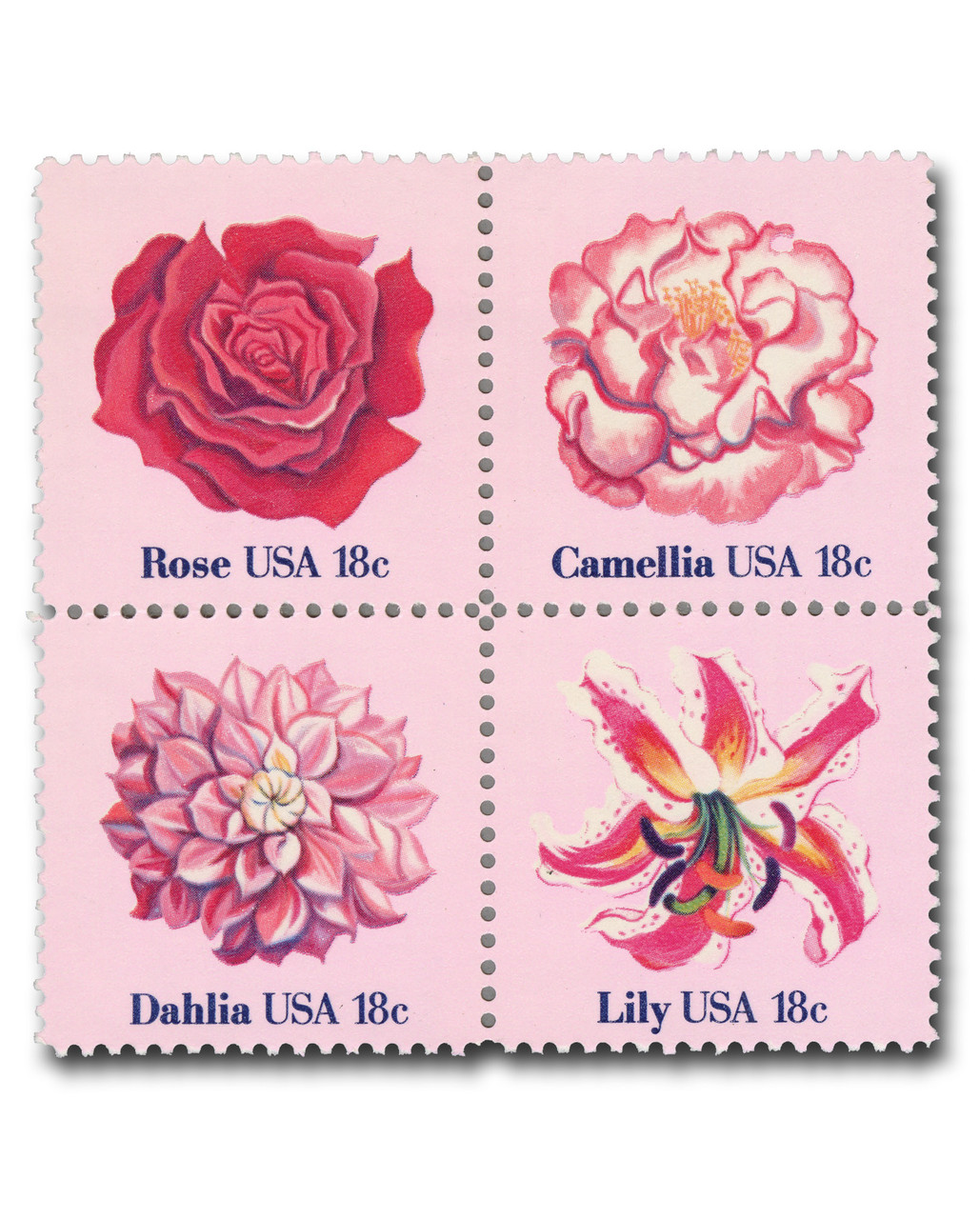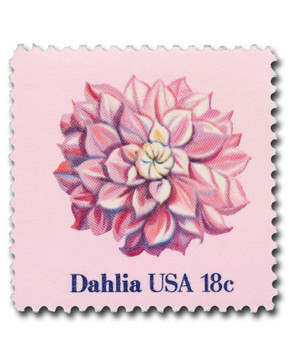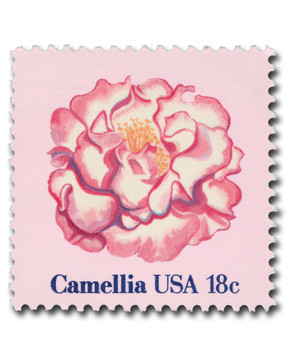
U.S. #1876-79
1981 18¢ Flowers
- First commemoratives issued for the new 18¢ first-class rate
- Stamps created “at the request of President Carter”
Stamp Category: Commemorative
Set: Flowers
Value: 18¢; first-class postage rate
First Day of Issue: April 23, 1981
First Day City: Fort Valley, Georgia
Quantity Issued: 52,658,250 blocks
Printed by: Bureau of Engraving & Printing
Printing Method: Photogravure
Format: Panes of 48 in sheets of 192
Perforations: 11
Why the stamps were issued: The block of four Flowers stamps were the first commemoratives issued at the new 18¢ first-class rate that went into effect March 22, 1981.
About the stamp designs: These were the first stamp designs for Lowell Nesbitt of New York City, who’s known for creating large-scale paintings of flowers. According to the USPS, the stamp images are “composite interpretations of several of his previous painting not representing specific species of flowers.” The flowers are largely pink and red, taking up most of the stamp space, all on a white background.
US #1876 pictures a deep red tea rose.
The American Camellia Society identified the pink-edged, white flower camellia on US #1877 as the “Betty Sheffield Supreme.”
The dahlia stamp on US #1878 pictures what is believed to be a pink and white cactus type of dahlia.
The red spotted white lily on US #1879 is suspected to be an Oriental hybrid variety.
First Day City: The First Day Ceremony for the Flowers block was held at the headquarters of the American Camellia Society in Fort Valley, Georgia.
About the Flowers Stamps: These stamps are largely the result of campaigning by the American Camellia Society (ACS). The ACS had requested a stamp featuring their signature flower for several years. Some members of the group were friends of former President Jimmy Carter, who was living in Plains, Georgia, near their headquarters in Fort Valley. They appear to have passed their suggestion to the former president, who in turn wrote a letter to the postmaster general asking for a camelia stamp. While the Citizens’ Stamp Advisory Committee initially questioned the importance of a camellia stamp, they ultimately agreed, and expanded the issue to a block of four. In announcing the issue, the USPS said the Flowers block of four was created “at the request of President Carter.”
History the stamp represents: This block of four stamps pays tribute to the beauty of America's flowers and pictures four of the most-beautiful varieties in the country.
Roses
Say the word “rose,” and it conjures up images of one of the most beautiful of all flowers. With its delicate, sweet-smelling blossom, this lovely flower has long been a symbol of beauty.
First cultivated in Asia, the rose has become popular in many countries throughout the world. In fact, it is the national flower of the United States, and several states including Georgia, Iowa, and North Dakota have chosen the rose as their state flower.
One of the largest and most important families of flowering plants, the rose family contains over 3,400 species of trees, shrubs, and herbs - including plants that produce fruit, such as pears, peaches, plums, and cherries.
In addition to being used for decoration, the rose provides us with several useful products. Fine woods from its various trees are used in cabinetmaking and woodworking. Attar, an oil obtained from the rose petal is used to make perfumes. And the edible, berrylike “fruit” of the rose, called hips, is used in making teas, jellies, and other preserves.
Camellias
Camellias are evergreen flowering shrubs native to eastern and southern Asia, but they’re also commonly found in gardens in the United States. Around 3,000 cultivars (including hybrid species) are known today, with most known for their early flowering. They are some of the first flowers to bloom, with blossoms appearing in late winter.
Most camellia varieties are hardy down to United States Department of Agriculture Zone 7, meaning they can withstand winter temperatures down to 0 ºF. However, there are a select few that can also survive in Zone 6, withstanding winter temperatures down to -10 ºF. This has allowed camellias to thrive in all but the coldest regions of the United States. Camellias have large flowers that range in color from white to pink to red, although some yellow varieties exist in South China and Vietnam. Blossoms have five to nine petals arranged in single, semi-double, or double patterns.
In addition to their beauty, camellias are also known for their role in the tea industry. The leaves and buds of the variety Camellia sinensis have been used to make tea for thousands of years. It would be perfect to spend a cold winter morning drinking a hot cup of tea (made from camellias) while enjoying the view of the related flowers blooming in your backyard.
Dahlias
The dahlia shows how plants were dispersed worldwide during the age of exploration. Naturalist Francisco Hernandez sent some native Mexican flowers to Philip II of Spain. Captivated by the blood-red beauties, the king decreed them a Spanish possession, forbidding their removal from the royal gardens. But the living treasure could not be hoarded. Soon, dahlias appeared throughout Europe. They were named in honor of Andreas Dahl, pupil of Linneaus, originator of the scientific classification system.
Europe entered a dahlia craze. In 1838 a single plant was exchanged for a rare diamond; later, a £1,000 prize was offered for a blue dahlia. Fifty years after the dahlia’s arrival, over 2,000 hybrids had been developed from the single Mexican species. Besides adorning gardens, dahlia tubers were used for medicinal purposes. High in fructose, they helped in the treatment of diabetes, as well as kidney and liver diseases.
The dahlia (cocoxochitl) was sacred to the Aztecs. This blood-red flower symbolized the mother of their war god. Because the blooms had eight petals, human sacrifice to the god occurred every eight years. Ironically, another legend associated the cocoxochitl with Quetzalcoatl, the Aztec god of peace.
Lilies
One of the world’s most beautiful flowers, the lily is also one of the oldest plants known to man. It is mentioned in history for the first time on a tablet inscribed nearly 5,000 years ago in Sumer. The tablet tells of a Persian city surrounded by fields of lilies. That ancient city was called Susa, which means lily.
From Persia the lily spread to Crete, Egypt, Greece, and Rome. It is believed caravans of nomads took the edible bulbs along as food for their long journeys. Occasionally a bulb would drop and take root. Eventually the lily made it to northern Europe and England, most likely in the belongings of homesick Roman soldiers.
Wherever it went, the lily was usually regarded as a sacred flower. The Minoans, Greeks, and Romans associated it with their goddesses. Greek mythology claimed the flower had sprung from the milk of Hera, Zeus’s wife. Closely intertwined with Christian history, the white lily was used for centuries to symbolize the purity of the Virgin Mary and her role as Queen of the Angels.
Today there are more than 12,000 species offering a multitude of colors, shapes, and sizes. Popular varieties include the tiger lily, Easter lily, and Japanese lily.
U.S. #1876-79
1981 18¢ Flowers
- First commemoratives issued for the new 18¢ first-class rate
- Stamps created “at the request of President Carter”
Stamp Category: Commemorative
Set: Flowers
Value: 18¢; first-class postage rate
First Day of Issue: April 23, 1981
First Day City: Fort Valley, Georgia
Quantity Issued: 52,658,250 blocks
Printed by: Bureau of Engraving & Printing
Printing Method: Photogravure
Format: Panes of 48 in sheets of 192
Perforations: 11
Why the stamps were issued: The block of four Flowers stamps were the first commemoratives issued at the new 18¢ first-class rate that went into effect March 22, 1981.
About the stamp designs: These were the first stamp designs for Lowell Nesbitt of New York City, who’s known for creating large-scale paintings of flowers. According to the USPS, the stamp images are “composite interpretations of several of his previous painting not representing specific species of flowers.” The flowers are largely pink and red, taking up most of the stamp space, all on a white background.
US #1876 pictures a deep red tea rose.
The American Camellia Society identified the pink-edged, white flower camellia on US #1877 as the “Betty Sheffield Supreme.”
The dahlia stamp on US #1878 pictures what is believed to be a pink and white cactus type of dahlia.
The red spotted white lily on US #1879 is suspected to be an Oriental hybrid variety.
First Day City: The First Day Ceremony for the Flowers block was held at the headquarters of the American Camellia Society in Fort Valley, Georgia.
About the Flowers Stamps: These stamps are largely the result of campaigning by the American Camellia Society (ACS). The ACS had requested a stamp featuring their signature flower for several years. Some members of the group were friends of former President Jimmy Carter, who was living in Plains, Georgia, near their headquarters in Fort Valley. They appear to have passed their suggestion to the former president, who in turn wrote a letter to the postmaster general asking for a camelia stamp. While the Citizens’ Stamp Advisory Committee initially questioned the importance of a camellia stamp, they ultimately agreed, and expanded the issue to a block of four. In announcing the issue, the USPS said the Flowers block of four was created “at the request of President Carter.”
History the stamp represents: This block of four stamps pays tribute to the beauty of America's flowers and pictures four of the most-beautiful varieties in the country.
Roses
Say the word “rose,” and it conjures up images of one of the most beautiful of all flowers. With its delicate, sweet-smelling blossom, this lovely flower has long been a symbol of beauty.
First cultivated in Asia, the rose has become popular in many countries throughout the world. In fact, it is the national flower of the United States, and several states including Georgia, Iowa, and North Dakota have chosen the rose as their state flower.
One of the largest and most important families of flowering plants, the rose family contains over 3,400 species of trees, shrubs, and herbs - including plants that produce fruit, such as pears, peaches, plums, and cherries.
In addition to being used for decoration, the rose provides us with several useful products. Fine woods from its various trees are used in cabinetmaking and woodworking. Attar, an oil obtained from the rose petal is used to make perfumes. And the edible, berrylike “fruit” of the rose, called hips, is used in making teas, jellies, and other preserves.
Camellias
Camellias are evergreen flowering shrubs native to eastern and southern Asia, but they’re also commonly found in gardens in the United States. Around 3,000 cultivars (including hybrid species) are known today, with most known for their early flowering. They are some of the first flowers to bloom, with blossoms appearing in late winter.
Most camellia varieties are hardy down to United States Department of Agriculture Zone 7, meaning they can withstand winter temperatures down to 0 ºF. However, there are a select few that can also survive in Zone 6, withstanding winter temperatures down to -10 ºF. This has allowed camellias to thrive in all but the coldest regions of the United States. Camellias have large flowers that range in color from white to pink to red, although some yellow varieties exist in South China and Vietnam. Blossoms have five to nine petals arranged in single, semi-double, or double patterns.
In addition to their beauty, camellias are also known for their role in the tea industry. The leaves and buds of the variety Camellia sinensis have been used to make tea for thousands of years. It would be perfect to spend a cold winter morning drinking a hot cup of tea (made from camellias) while enjoying the view of the related flowers blooming in your backyard.
Dahlias
The dahlia shows how plants were dispersed worldwide during the age of exploration. Naturalist Francisco Hernandez sent some native Mexican flowers to Philip II of Spain. Captivated by the blood-red beauties, the king decreed them a Spanish possession, forbidding their removal from the royal gardens. But the living treasure could not be hoarded. Soon, dahlias appeared throughout Europe. They were named in honor of Andreas Dahl, pupil of Linneaus, originator of the scientific classification system.
Europe entered a dahlia craze. In 1838 a single plant was exchanged for a rare diamond; later, a £1,000 prize was offered for a blue dahlia. Fifty years after the dahlia’s arrival, over 2,000 hybrids had been developed from the single Mexican species. Besides adorning gardens, dahlia tubers were used for medicinal purposes. High in fructose, they helped in the treatment of diabetes, as well as kidney and liver diseases.
The dahlia (cocoxochitl) was sacred to the Aztecs. This blood-red flower symbolized the mother of their war god. Because the blooms had eight petals, human sacrifice to the god occurred every eight years. Ironically, another legend associated the cocoxochitl with Quetzalcoatl, the Aztec god of peace.
Lilies
One of the world’s most beautiful flowers, the lily is also one of the oldest plants known to man. It is mentioned in history for the first time on a tablet inscribed nearly 5,000 years ago in Sumer. The tablet tells of a Persian city surrounded by fields of lilies. That ancient city was called Susa, which means lily.
From Persia the lily spread to Crete, Egypt, Greece, and Rome. It is believed caravans of nomads took the edible bulbs along as food for their long journeys. Occasionally a bulb would drop and take root. Eventually the lily made it to northern Europe and England, most likely in the belongings of homesick Roman soldiers.
Wherever it went, the lily was usually regarded as a sacred flower. The Minoans, Greeks, and Romans associated it with their goddesses. Greek mythology claimed the flower had sprung from the milk of Hera, Zeus’s wife. Closely intertwined with Christian history, the white lily was used for centuries to symbolize the purity of the Virgin Mary and her role as Queen of the Angels.
Today there are more than 12,000 species offering a multitude of colors, shapes, and sizes. Popular varieties include the tiger lily, Easter lily, and Japanese lily.










